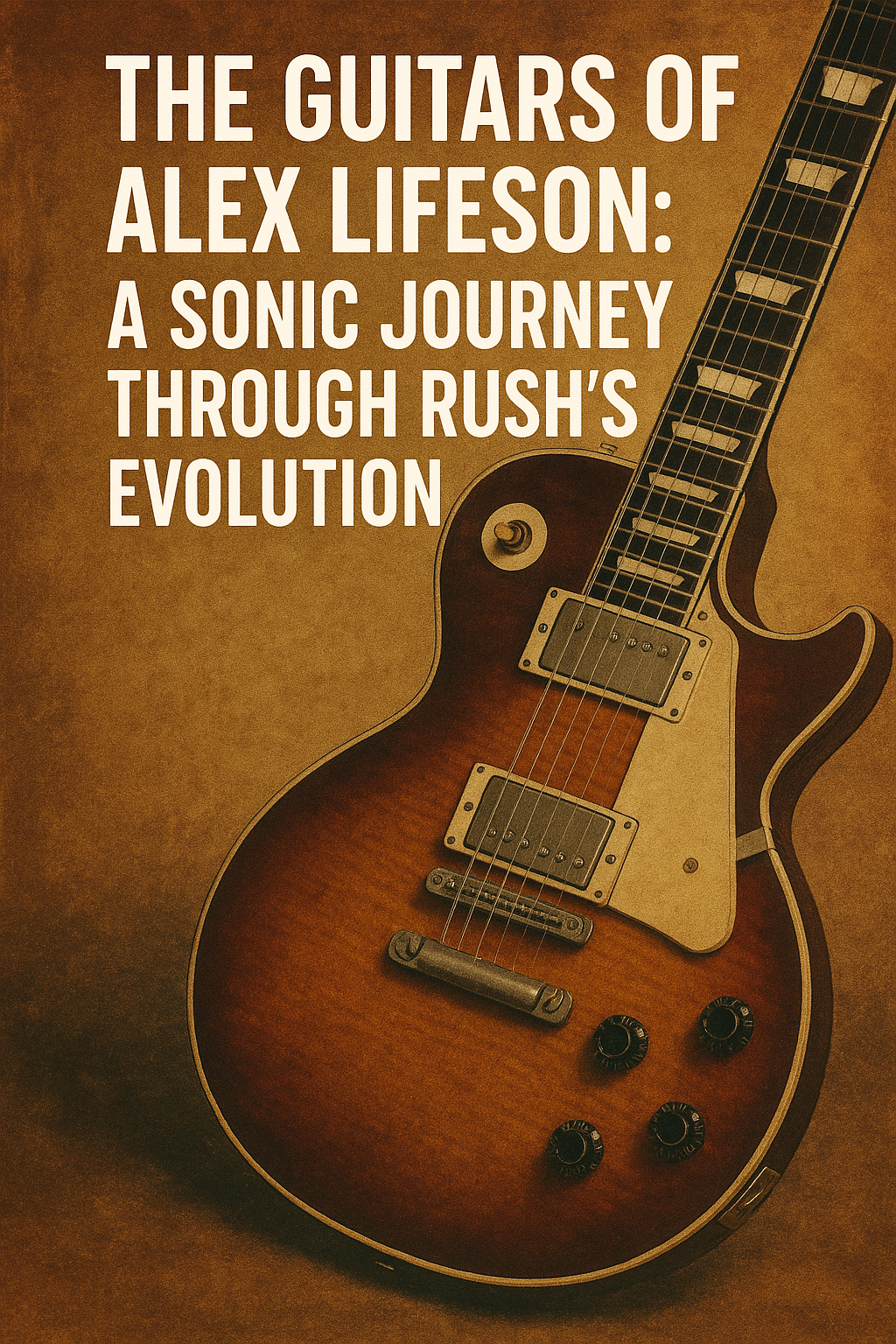From the heavy riffs of Fly by Night to the atmospheric textures of Grace Under Pressure, Alex Lifeson has been the six-string architect behind Rush’s ever-evolving sound. Known for blending intricate chord voicings with soaring solos and experimental tones, Lifeson’s guitar choices over the decades reflect his restless musical curiosity. Let’s take a journey through the iconic guitars that shaped his sound across Rush’s discography.
Early Years (1970s): Gibson ES-335, SG, and the White 355
In Rush’s early days, Lifeson leaned heavily on Gibson guitars to deliver the classic hard rock tone that defined albums like Rush (1974), Fly by Night (1975), and 2112 (1976).
-
Gibson ES-335: One of his earliest touring guitars. Warm, full-bodied tone ideal for early progressive hard rock.
-
Gibson SG Standard: Used during the Fly by Night era; lightweight and aggressive with that classic PAF growl.
-
Gibson ES-355 Alpine White (with Bigsby): Perhaps his most iconic 1970s guitar. Featured prominently on A Farewell to Kings (1977) and Hemispheres (1978), this guitar became synonymous with his progressive lead tones and expressive vibrato.
Signature Tone: Chorus-laden cleans and thick, articulate leads—often achieved by blending his Gibson tone with delay and subtle modulation.
Transition to Solid Bodies (Early 1980s): Gibson Les Pauls and Fender Stratocaster
As the band’s sound matured on albums like Permanent Waves (1980) and Moving Pictures (1981), Lifeson began to integrate a wider palette of tones.
-
Gibson Les Paul Custom & Standard: These were used extensively for rhythm and lead tracks. The Les Paul’s fat midrange suited the band’s increasingly intricate arrangements.
-
Fender Stratocaster (often modified with humbuckers): Used live and in the studio for brighter, more articulate passages. Perfect for songs like “Limelight” and “Red Barchetta”.
Signature Sound: Combining a Les Paul’s punch with Strat-like clarity helped him balance power and articulation within Rush’s trio format.
Synth Era (Mid-1980s): Hentor Sportscaster and Signature Hybrids
With Rush embracing more synthesizers and electronic textures, Lifeson needed guitars that could keep up with evolving production demands.
-
“Hentor Sportscaster”: A heavily modified Strat-style guitar (originally a Fender body with a Floyd Rose, DiMarzio humbuckers, and custom wiring). Used extensively on Grace Under Pressure (1984), Power Windows (1985), and Hold Your Fire (1987).
-
Gibson Howard Roberts Fusion: Semi-hollow body with jazzy tones and surprising versatility—used in the studio during the mid-80s.
-
Steinberger GL2T: Headless, futuristic, and MIDI-capable—Lifeson used it on Power Windows tour for its tuning stability and compact design.
Signature Sound: Chorus, delay, and rack effects played a huge role. Lifeson’s rhythm tones became more textural and ambient during this time.
Back to Organic (1990s): PRS and Return of Gibson
As Rush moved into the 90s with albums like Counterparts (1993) and Test for Echo (1996), Lifeson returned to more organic, aggressive tones.
-
Paul Reed Smith (PRS Custom 24): Lifeson gravitated toward PRS for their balanced tone, playability, and reliability. Used heavily in the studio and on tour.
-
Gibson Les Paul Axcess: A modern update to the classic LP, featuring a Floyd Rose tremolo and ergonomic neck heel—blending tradition with flexibility.
-
Fender Telecasters: Occasionally used for cleaner, twangier textures during the Test for Echo era.
Signature Tone: Heavier, punchier tones with less modulation—signalling a return to guitar-driven rock.
Modern Era (2000s–2015): Signature Models and Acoustic Experimentation
In Rush’s final years, including Snakes & Arrows (2007) and Clockwork Angels (2012), Lifeson employed a refined rig combining vintage warmth with modern versatility.
-
Gibson Custom Alex Lifeson Les Paul Axcess: His signature model featured piezo pickups and a Floyd Rose system, allowing for both electric and acoustic tones in one instrument.
-
Gibson EDS-1275 Double Neck: Used live for “Xanadu” and “The Trees,” this iconic beast was essential for switching between 6- and 12-string parts.
-
Gibson J-55 / J-200 / Martin D-28: Lifeson used a variety of acoustics for lush textures on songs like “Hope” and “Bravest Face.”
Signature Sound: Sophisticated signal routing and the use of piezo systems let him blend acoustic and electric voices in real time.
Lerxst Brand and Current Projects
In the years following Rush’s retirement from touring, Lifeson launched his Lerxst brand:
-
Lerxst Limelight Guitar: A modern take on his beloved Hentor Sportscaster, updated for today’s players. High-output pickups, Floyd Rose, and custom specs.
-
Lerxst Amps: Collaborating with Mojotone, Lifeson now produces his own line of boutique amplifiers, continuing his passion for tone shaping.
Final Thoughts: A Legacy of Exploration
Alex Lifeson’s gear choices reflect his fearless evolution as a guitarist—from hard rock hero to ambient soundscaper. Whether wielding a Gibson ES-355 in the ‘70s or a custom PRS in the ‘90s, Lifeson always prioritised texture, tone, and musicality over flash.
His rig wasn’t just about gear—it was about storytelling, and Rush’s music tells one of the most intricate sonic tales in rock history.
🎸 Notable Lifeson Guitars at a Glance:
|
Era |
Guitar |
Key Albums |
|---|---|---|
|
1970s |
Gibson ES-355, SG, Les Paul |
2112, Hemispheres |
|
Early 80s |
Les Paul, Stratocaster |
Moving Pictures, Signals |
|
Mid-80s |
Hentor Sportscaster, Steinberger |
Grace Under Pressure, Power Windows |
|
1990s |
PRS Custom 24, Gibson Axcess |
Counterparts, Test for Echo |
|
2000s–2010s |
Gibson Axcess, J-200, Lerxst Limelight |
Snakes & Arrows, Clockwork Angels |









